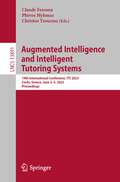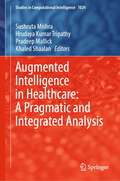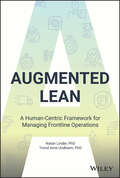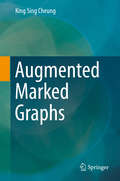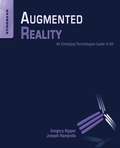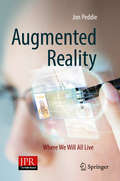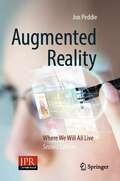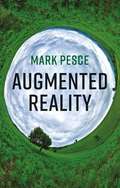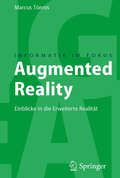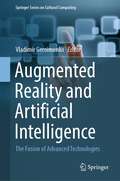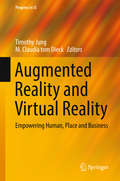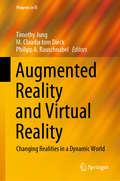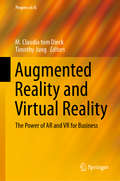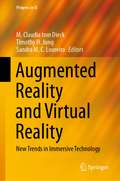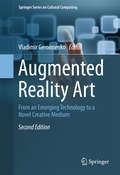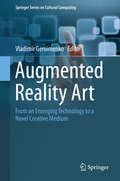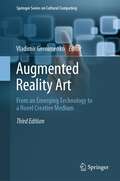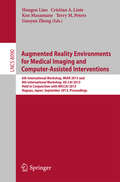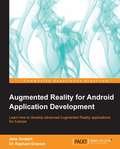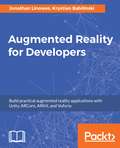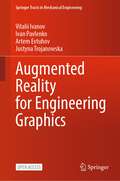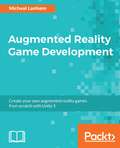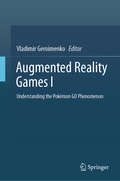- Table View
- List View
Augmented Intelligence and Intelligent Tutoring Systems: 19th International Conference, ITS 2023, Corfu, Greece, June 2–5, 2023, Proceedings (Lecture Notes in Computer Science #13891)
by Claude Frasson Phivos Mylonas Christos TroussasThis book constitutes the refereed proceedings of the 19th International Conference on Augmented Intelligence and Intelligent Tutoring Systems, ITS 2023, held in Corfu, Greece, during June 2-5, 2023. The 41 full papers and 19 short papers presented in this book were carefully reviewed and selected from 84 submissions. The papers are divided into the following topical sections: augmented intelligence in tutoring systems; augmented intelligence in healthcare informatics; augmented intelligence in games, serious games and virtual reality; neural networks and data mining; augmented intelligence and metaverse; security, privacy and ethics in augmented intelligence; and applied natural language processing.
Augmented Intelligence in Healthcare: A Pragmatic and Integrated Analysis (Studies in Computational Intelligence #1024)
by Sushruta Mishra Hrudaya Kumar Tripathy Pradeep Mallick Khaled ShaalanThe book discusses how augmented intelligence can increase the efficiency and speed of diagnosis in healthcare organizations. The concept of augmented intelligence can reflect the enhanced capabilities of human decision-making in clinical settings when augmented with computation systems and methods. It includes real-life case studies highlighting impact of augmented intelligence in health care. The book offers a guided tour of computational intelligence algorithms, architecture design, and applications of learning in healthcare challenges. It presents a variety of techniques designed to represent, enhance, and empower multi-disciplinary and multi-institutional machine learning research in healthcare informatics. It also presents specific applications of augmented intelligence in health care, and architectural models and frameworks-based augmented solutions.
Augmented Lean: A Human-Centric Framework for Managing Frontline Operations
by Natan Linder Trond Arne UndheimExplore the real future of work in this expert tech implementation guide that goes beyond automation In Augmented Lean: A Human-Centric Framework for Managing Frontline Operations, serial startup founder Dr. Natan Linder and futurist podcaster Dr. Trond Arne Undheim deliver an urgent and incisive exploration of how to facilitate agile processes amongst a millennial workforce that already lives by many of its tenets. The book demonstrates how to abandon legacy industrial technology that is failing modern operations and hindering operational excellence and digital progress. As an executive and leader, you cannot fall prey to hyped-up notions of industry 4.0's factory of the future automation, artificial intelligence, internet of things, sensors, digital twins, and augmented reality fixing every problem. Instead, to truly reduce cognitive load, complexity, and frustrations in the workplace, we must build cyber-physical technologies so that humans remain at the center. Leaders must ensure that the technology they deploy at an industrial scale has fluid interfaces that demonstrably simplifies work and makes operations more flexible without introducing fear, uncertainty, or doubt. The authors provide: A step-by-step walkthrough of the Augmented Lean framework that shows readers when, how, and why to augment your workforce through cyber-physical principles that go beyond both Lean and Agile management practices Concrete strategies on how to scale these operational augmentation methods throughout your organization based on real-world case studies of operators in the trenches of manufacturing whose impact far outweighs their seniority in the corporate hierarchy Insightful advice for how to use the augmentation framework in small- and medium-sized enterprises where license and training costs are prohibitive when only using off-the-shelf industry 4.0 approaches A thoroughly practical playbook for augmenting your workforce with the latest cyber-physical adaptations to digital technologies, Augmented Lean provides you with the organizational-, process-, and management-level techniques you need to get the most out of your employees. In turn, as an operator, engineer, or industrial worker reading this book, you will become empowered to be a change agent through no-code interfaces instead of remaining a recipient of endless training demands and ever-increasing technological complexity. Augmented Lean will orient you towards the future with the most effective tools to cut through hype so you can instantly apply your learnings and be productive wherever you currently operate.
Augmented Lean: A Human-Centric Framework for Managing Frontline Operations
by Natan Linder Trond Arne UndheimExplore the real future of work in this expert tech implementation guide that goes beyond automation In Augmented Lean: A Human-Centric Framework for Managing Frontline Operations, serial startup founder Dr. Natan Linder and futurist podcaster Dr. Trond Arne Undheim deliver an urgent and incisive exploration of how to facilitate agile processes amongst a millennial workforce that already lives by many of its tenets. The book demonstrates how to abandon legacy industrial technology that is failing modern operations and hindering operational excellence and digital progress. As an executive and leader, you cannot fall prey to hyped-up notions of industry 4.0's factory of the future automation, artificial intelligence, internet of things, sensors, digital twins, and augmented reality fixing every problem. Instead, to truly reduce cognitive load, complexity, and frustrations in the workplace, we must build cyber-physical technologies so that humans remain at the center. Leaders must ensure that the technology they deploy at an industrial scale has fluid interfaces that demonstrably simplifies work and makes operations more flexible without introducing fear, uncertainty, or doubt. The authors provide: A step-by-step walkthrough of the Augmented Lean framework that shows readers when, how, and why to augment your workforce through cyber-physical principles that go beyond both Lean and Agile management practices Concrete strategies on how to scale these operational augmentation methods throughout your organization based on real-world case studies of operators in the trenches of manufacturing whose impact far outweighs their seniority in the corporate hierarchy Insightful advice for how to use the augmentation framework in small- and medium-sized enterprises where license and training costs are prohibitive when only using off-the-shelf industry 4.0 approaches A thoroughly practical playbook for augmenting your workforce with the latest cyber-physical adaptations to digital technologies, Augmented Lean provides you with the organizational-, process-, and management-level techniques you need to get the most out of your employees. In turn, as an operator, engineer, or industrial worker reading this book, you will become empowered to be a change agent through no-code interfaces instead of remaining a recipient of endless training demands and ever-increasing technological complexity. Augmented Lean will orient you towards the future with the most effective tools to cut through hype so you can instantly apply your learnings and be productive wherever you currently operate.
Augmented Marked Graphs
by King Sing CheungPetri nets are a formal and theoretically rich model for the modelling and analysis of systems. A subclass of Petri nets, augmented marked graphs possess a structure that is especially desirable for the modelling and analysis of systems with concurrent processes and shared resources.This monograph consists of three parts: Part I provides the conceptual background for readers who have no prior knowledge on Petri nets; Part II elaborates the theory of augmented marked graphs; finally, Part III discusses the application to system integration. The book is suitable as a first self-contained volume on augmented marked graphs, and will be useful to both researchers and practitioners in the fields of Petri nets and system integration.
Augmented Reality: An Emerging Technologies Guide to AR
by Greg Kipper Joseph RampollaWith the explosive growth in mobile phone usage and rapid rise in search engine technologies over the last decade, augmented reality (AR) is poised to be one of this decade's most disruptive technologies, as the information that is constantly flowing around us is brought into view, in real-time, through augmented reality. In this cutting-edge book, the authors outline and discuss never-before-published information about augmented reality and its capabilities. With coverage of mobile, desktop, developers, security, challenges, and gaming, this book gives you a comprehensive understanding of what augmented reality is, what it can do, what is in store for the future and most importantly: how to benefit from using AR in our lives and careers.Educates readers how best to use augmented reality regardless of industryProvides an in-depth understanding of AR and ideas ranging from new business applications to new crime fighting methods Includes actual examples and case studies from both private and government application
Augmented Reality: An Emerging Technologies Guide to AR
by Greg Kipper Joseph RampollaWith the explosive growth in mobile phone usage and rapid rise in search engine technologies over the last decade, augmented reality (AR) is poised to be one of this decade's most disruptive technologies, as the information that is constantly flowing around us is brought into view, in real-time, through augmented reality. In this cutting-edge book, the authors outline and discuss never-before-published information about augmented reality and its capabilities. With coverage of mobile, desktop, developers, security, challenges, and gaming, this book gives you a comprehensive understanding of what augmented reality is, what it can do, what is in store for the future and most importantly: how to benefit from using AR in our lives and careers.Educates readers how best to use augmented reality regardless of industryProvides an in-depth understanding of AR and ideas ranging from new business applications to new crime fighting methods Includes actual examples and case studies from both private and government application
Augmented Reality: Where We Will All Live
by Jon PeddieThis book provides an in-depth exploration of the field of augmented reality (AR) in its entirety and sets out to distinguish AR from other inter-related technologies like virtual reality (VR) and mixed reality (MR). The author presents AR from its initial philosophies and early developments, to its current technologies and its impact on our modern society, to its possible future developments; providing readers with the tools to understand issues relating to defining, building, and using our perception of what is represented in our perceived reality, and ultimately how we assimilate and react to this information. Augmented Reality: Where We Will All Live can be used as a comprehensive guide to the field of AR and provides valuable insights for technologists, marketers, business managers, educators and academics who are interested in the field of augmented reality; its concepts, history, practices and the science behind this rapidly advancing field of research and development.
Augmented Reality: Where We Will All Live
by Jon PeddieThis book provides an in-depth exploration of the field of augmented reality (AR) in its entirety and sets out to distinguish AR from other inter-related technologies like virtual reality (VR), mixed reality (MR) and extended reality (XR). The author presents AR from its initial philosophies and early developments, and in this updated 2nd edition discusses the latest advances and the ramifications they bring and the impact they have on modern society. He examines the new companies that have entered the field and those that have failed or were acquired giving a complete history of AR progress. He explores the possible future developments providing readers with the tools to understand issues relating to defining, building, and using their perception of what is represented in their perceived reality, and ultimately how we assimilate and react to this information. In Augmented Reality: Where We Will All Live 2nd Edition, Jon Peddie has amassed and integrated a corpus of material that is finally in one place. It will serve as a comprehensive guide and provide valuable insights for technologists, marketers, business managers, educators and academics who are interested in the field of augmented reality, its concepts, history, practices, and the science behind this rapidly advancing field of research and development.
Augmented Reality: Unboxing Tech's Next Big Thing
by Mark PesceSlated as ‘the next big thing in tech’, augmented reality promises to take the screen out of our hands and wrap it around the world via ‘smart spectacles’. As a pervasive, invisible interface between the world and our senses, AR offers unparalleled capacity to reveal hidden digital depths, but it also comes at a cost to our privacy, our property, and our reality. In this crucial and provocative book, Mark Pesce draws on over thirty years’ experience to offer the first mainstream exploration of augmented reality. He discusses the exciting and beneficial features of AR as well as the issues and risks raised by this still-emerging technology – a technology that moulds us by shaping what we see and hear. Augmented Reality is essential reading for anyone interested in the growing influence of this impressive but deeply concerning technology. As the book reveals, reality - once augmented - will never be the same.
Augmented Reality: Einblicke in die Erweiterte Realität (Informatik im Fokus)
by Marcus TönnisDer Autor befasst sich mit der Überlagerung der realen Welt durch computergenerierte virtuelle Objekte. Die drei grundlegenden Bausteine dieser erweiterten Realität, Darstellung, Tracking und Benutzerinteraktion, werden Schritt für Schritt eingeführt und miteinander in Zusammenhang gebracht. Ein Überblick über Anwendungen in Forschung und Industrie liefert Anregungen für die Entwicklung eigener Systeme. Leser können den Stoff anhand zahlreicher Übungen vertiefen.
Augmented Reality and Artificial Intelligence: The Fusion of Advanced Technologies (Springer Series on Cultural Computing)
by Vladimir GeroimenkoThis book is the first research monograph that explores a new research field and practical applications produced by the combined use of two of the most advanced and powerful technologies available in today’s world – Artificial Intelligence (AI) and Augmented Reality (AR). It is written by a team of 50 researchers and practitioners from 16 countries, which has enabled a thorough coverage of emerging or previously unexplored subject areas. The authors consider practical, theoretical, and cultural aspects of “AI-powered AR” and “AR-enriched AI”, and their usage in a large variety of areas, such as education, medicine, healthcare, dentistry, pharmacy, active lifestyle, smart services, fashion, retail, recommender systems, and several others. Augmented Reality and Artificial Intelligence: The Fusion of Advanced Technologies is essential reading not only for researchers, practitioners and technology developers, but also for students (both graduates and undergraduates) and anyone who is interested in building a comprehensive understanding of the emerging fields of “intelligent augmented environments” and “artificial intelligence presented by augmented reality”.
Augmented Reality and Virtual Reality: Empowering Human, Place and Business (Progress in IS)
by Timothy Jung M. Claudia tom DieckThis volume provides the latest outcomes of augmented reality (AR) and virtual reality (VR) research conducted in various industries. It reveals how AR and VR are currently changing the business landscape, and how new innovations provide opportunities for businesses to offer their customers unique services and experiences. Collecting the proceedings of the International AR & VR Conference held in Manchester, UK, in February 2017, the book advances the state of the art in AR and VR technologies and their applications in various industries such as tourism, hospitality, events, fashion, entertainment, retail, education and the gaming industry. The papers presented here cover the most significant topics within the field of AR and VR for both researchers and practitioners, approaching them from a business and management perspective.
Augmented Reality and Virtual Reality: Changing Realities in a Dynamic World (Progress in IS)
by Timothy Jung M. Claudia tom Dieck Philipp A. RauschnabelThis book features the latest research in the area of immersive technologies, presented at the 5th International Augmented and Virtual Reality Conference, held in Munich, Germany in 2019. Bridging the gap between academia and industry, it presents the state of the art in augmented reality (AR) and virtual reality (VR) technologies and their applications in various industries such as marketing, education, healthcare, tourism, events, fashion, entertainment, retail and the gaming industry. The volume is a collection of research papers by prominent AR and VR scholars from around the globe. Covering the most significant topics in the field of augmented and virtual reality and providing the latest findings, it is of interest to academics and practitioners alike.
Augmented Reality and Virtual Reality: The Power of AR and VR for Business (Progress in IS)
by M. Claudia tom Dieck Timothy JungThis book presents a collection of the latest research in the area of immersive technologies, presented at the International Augmented and Virtual Reality Conference 2018 in Manchester, UK, and showcases how augmented reality (AR) and virtual reality (VR) are transforming the business landscape. Innovations in this field are seen as providing opportunities for businesses to offer their customers unique services and experiences. The papers gathered here advance the state of the art in AR/VR technologies and their applications in various industries such as healthcare, tourism, hospitality, events, fashion, entertainment, retail, education and gaming. The volume collects contributions by prominent computer and social sciences experts from around the globe. Addressing the most significant topics in the field of augmented and virtual reality and sharing the latest findings, it will be of interest to academics and practitioners alike.
Augmented Reality and Virtual Reality: New Trends in Immersive Technology (Progress in IS)
by M. Claudia tom Dieck Timothy H. Jung Sandra M. C. LoureiroThis book features the latest research in the area of immersive technologies, presented at the 6th International Augmented Reality and Virtual Reality Conference, held in online in 2020. Bridging the gap between academia and industry, it presents the state of the art in augmented reality (AR) and virtual reality (VR) technologies and their applications in various industries such as marketing, education, health care, tourism, events, fashion, entertainment, retail and the gaming industry.The book is a collection of research papers by prominent AR and VR scholars from around the globe. Covering the most significant topics in the field of augmented and virtual reality and providing the latest findings, it is of interest to academics and practitioners alike.
Augmented Reality Art: From an Emerging Technology to a Novel Creative Medium (Springer Series on Cultural Computing)
by Vladimir GeroimenkoThis is the second edition of the first ever book to explore the exciting new field of augmented reality art and its enabling technologies. The new edition has been thoroughly revised and updated, and contains 5 new chapters. As well as investigating augmented reality as a novel artistic medium the book covers cultural, social, spatial and cognitive facets of augmented reality art. Intended as a starting point for exploring this new fascinating area of research and creative practice it will be essential reading not only for artists, researchers and technology developers, but also for students (graduates and undergraduates) and all those interested in emerging augmented reality technology and its current and future applications in art.
Augmented Reality Art: From an Emerging Technology to a Novel Creative Medium (Springer Series on Cultural Computing)
by Vladimir GeroimenkoWritten by a team of world-renowned artists, researchers and practitioners - all pioneers in using augmented reality based creative works and installations as a new form of art - this is the first book to explore the exciting new field of augmented reality art and its enabling technologies. As well as investigating augmented reality as a novel artistic medium the book covers cultural, social, spatial and cognitive facets of augmented reality art. Intended as a starting point for exploring this new fascinating area of research and creative practice it will be essential reading not only for artists, researchers and technology developers, but also for students (graduates and undergraduates) and all those interested in emerging augmented reality technology and its current and future applications in art.
Augmented Reality Art: From an Emerging Technology to a Novel Creative Medium (Springer Series on Cultural Computing)
by Vladimir GeroimenkoThis is the third edition of the first ever book to explore the exciting field of augmented reality art and its enabling technologies. The new edition has been thoroughly revised and updated, with 9 new chapters included. As well as investigating augmented reality as a novel artistic medium, the book covers cultural, social, spatial and cognitive facets of augmented reality art. It has been written by a virtual team of 33 researchers and artists from 11 countries who are pioneering in the new form of art, and contains numerous colour illustrations showing both classic and recent augmented reality artworks.Intended as a starting point for exploring this new fascinating area of research and creative practice, it will be essential reading not only for artists, researchers and technology developers, but also for students (graduates and undergraduates) and all those interested in emerging augmented reality technology and its current and future applications in art.
Augmented Reality Environments for Medical Imaging and Computer-Assisted Interventions: International Workshops (Lecture Notes in Computer Science #8090)
by Hongen Liao Cristian A. Linte Ken Masamune Terry M. Peters Guayan ZhengThis book constitutes the refereed proceedings of two workshops MAIR/AE-CAI 2013, held in conjunction with MICCAI 2013, held in Nagoya, Japan, in September 2013. The 29 revised full papers presented were carefully reviewed and selected from 44 submissions. The papers cover a wide range of topics addressing the main research efforts in the fields of medical image formation, analysis and interpretation, augmented reality and visualization, computer assisted intervention, interventional imaging, image-guided robotics, image-guided intervention, surgical planning and simulation, systematic extra- and intra-corporeal imaging modalities, and general biological and neuroscience image computing.
Augmented Reality for Android Application Development
by Jens Grubert Dr Raphael GrassetA step-by-step tutorial-based guide aimed at giving you hands-on practical experience to develop AR applications for Android.Augmented Reality for Android Application Development is for Android mobile application developers who are familiar with Android Development Tools and deployment, JMonkeyEngine, and the Vuforia SDK.
Augmented Reality for Developers: Build practical augmented reality applications with Unity, ARCore, ARKit, and Vuforia
by Jonathan Linowes Krystian BabilinskiBuild exciting AR applications on mobile and wearable devices with Unity 3D, Vuforia, ARToolKit, Microsoft Mixed Reality HoloLens, Apple ARKit, and Google ARCore About This Book • Create unique AR applications from scratch, from beginning to end, with step-by-step tutorials • Use Unity 3D to efficiently create AR apps for Android, iOS, and Windows platforms • Use Vuforia, ARTookKit, Windows Mixed Reality, and Apple ARKit to build AR projects for a variety of markets • Learn best practices in AR user experience, software design patterns, and 3D graphics Who This Book Is For The ideal target audience for this book is developers who have some experience in mobile development, either Android or iOS. Some broad web development experience would also be beneficial. What You Will Learn • Build Augmented Reality applications through a step-by-step, tutorial-style project approach • Use the Unity 3D game engine with the Vuforia AR platform, open source ARToolKit, Microsoft's Mixed Reality Toolkit, Apple ARKit, and Google ARCore, via the C# programming language • Implement practical demo applications of AR including education, games, business marketing, and industrial training • Employ a variety of AR recognition modes, including target images, markers, objects, and spatial mapping • Target a variety of AR devices including phones, tablets, and wearable smartglasses, for Android, iOS, and Windows HoloLens • Develop expertise with Unity 3D graphics, UIs, physics, and event systems • Explore and utilize AR best practices and software design patterns In Detail Augmented Reality brings with it a set of challenges that are unseen and unheard of for traditional web and mobile developers. This book is your gateway to Augmented Reality development—not a theoretical showpiece for your bookshelf, but a handbook you will keep by your desk while coding and architecting your first AR app and for years to come. The book opens with an introduction to Augmented Reality, including markets, technologies, and development tools. You will begin by setting up your development machine for Android, iOS, and Windows development, learning the basics of using Unity and the Vuforia AR platform as well as the open source ARToolKit and Microsoft Mixed Reality Toolkit. You will also receive an introduction to Apple's ARKit and Google's ARCore! You will then focus on building AR applications, exploring a variety of recognition targeting methods. You will go through multiple complete projects illustrating key market sectors including business marketing, education, industrial training, and gaming. By the end of the book, you will have gained the necessary knowledge to make quality content appropriate for a range of AR devices, platforms, and intended uses. Style and approach This book adopts a practical, step-by-step, tutorial-style approach. The design principles and methodology will be explained by creating different modules of the AR app.
Augmented Reality for Engineering Graphics (Springer Tracts in Mechanical Engineering)
by Vitalii Ivanov Ivan Pavlenko Artem Evtuhov Justyna TrojanowskaThis open access book offers a timely snapshot of Augmented Reality (AR) technology, with an emphasis on its application within the mechanical and manufacturing engineering domains, for both educational and industrial purposes. Reporting on the experience of the authors, the book introduces readers to the principles of product design, with an emphasis on modern strategies and approaches for user-centered design, creativity, and design for manufacturing and sustainability. It guides to the application augmented reality and visualization techniques in the design process. In turn, it describes an AR mobile application developed by the authors to transform 2D drawings into dynamic 3D objects. The book also includes exercises. All in all, this book offers a practice-oriented guide to Augmented Reality applications in mechanical engineering and education, addressing advanced undergraduate students, lecturers, and professionals in the engineering field. This is an open access book.
Augmented Reality Game Development
by Micheal Lanham 1 20 2017Create your own augmented reality games from scratch with Unity 5About This BookCreate your own augmented reality game from scratch and join the virtual reality gaming revolutionUse the latest Unity 5 VR SDK to create pro-level AR games like Pokemon GoInnovate and explore the latest and most promising trend of AR gaming in the mobile gaming industryWho This Book Is ForThis book is for those who have a basic knowledge of game development techniques, but no previous knowledge of Unity is required. Some basic programming knowledge would be desirable, but the book is an introduction to the topic. The book is also suitable for experienced developers new to GIS or GPS development.What You Will LearnBuild a location-based augmented reality game called Foodie GoAnimate a player's avatar on a mapUse the mobile device's camera as a game backgroundImplement database persistence with SQLLite4Unity3D to carry inventory items across game sessionsCreate basic UI elements for the game, inventory, menu, and settingsPerform location and content searches against the Google Places APIEnhance the game's mood by adding visual shader effectsExtend the game by adding multiplayer networking and other enhancementsIn DetailThe heyday of location-based augmented reality games is upon us. They have been around for a few years, but the release of Pokemon Go was a gamechanger that catalyzed the market and led to a massive surge in demand. Now is the time for novice and experienced developers alike to turn their good ideas into augmented reality (AR) mobile games and meet this demand!If you are keen to develop virtual reality games with the latest Unity 5 toolkit, then this is the book for you. The genre of location-based AR games introduces a new platform and technical challenges, but this book will help simplify those challenges and show how to maximize your game audience.This book will take you on a journey through building a location-based AR game that addresses the core technical concepts: GIS fundamentals, mobile device GPS, mapping, map textures in Unity, mobile device camera, camera textures in Unity, accessing location-based services, and other useful Unity tips. The technical material also discusses what is necessary for further development to create a multiplayer version of the game. At the end, you will be presented with troubleshooting techniques in case you get into trouble and need a little help.Style and approachThis book shows you how to create every step of the game and gives practical examples.
Augmented Reality Games I: Understanding the Pokémon GO Phenomenon
by Vladimir GeroimenkoThis is the first of two comprehensive volumes that provide a thorough and multi-faceted research into the emerging field of augmented reality games and consider a wide range of its major issues. These first ever research monographs on augmented reality games have been written by a team of 70 leading researchers, practitioners and artists from 20 countries. In Volume I, the phenomenon of the Pokémon GO game is analysed in theoretical, cultural and conceptual contexts, with emphasis on its nature and the educational use of the game in children and adolescents. Game transfer phenomena, motives for playing Pokémon GO, players’ experiences and memorable moments, social interaction, long-term engagement, health implications and many other issues raised by the Pokémon GO game are systematically examined and discussed. Augmented Reality Games I is essential reading not only for researchers, practitioners, game developers and artists, but also for students (graduates and undergraduates) and all those interested in the rapidly developing area of augmented reality games.
